We left Yellowstone NP today but not without a last sight of the two eagles perched over the river near our campsight looking for dinner.
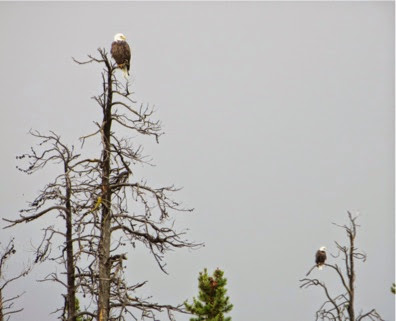
We traveled a l-o-o-ng way ( a whopping 67 miles) to Cody, WY, where we will stay in the Buffalo Bill State Park for 3 nights. Nice park right on the reservoir with scrumptious views out our windows. Maybe I’ll just sit here and look at the reservoir and the mountains on the other side. Well, maybe not.
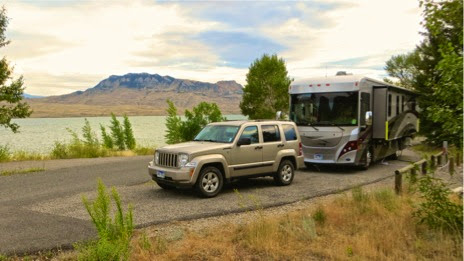
Since the trip was less than arduous, we had the afternoon to fill and found out that there was a Japanese confinement center just north of Cody. We have never gotten to Manzanar in California west of Death Valley, which is the National Memorial site and were excited to see the Cody site. I know you all know the outline of the story of the Japanese internment during WWII but I’ll just briefly cover what happened here at this site. It was February of 1942 when Roosevelt, under pressure from many on the western coast, issued Executive Order 9066 which led to the forced removal of persons of Japanese ancestry from the West Coast. The order affected 120,000 people, 2/3, or 80,000, of whom were American citizens. The line was arbitrary, in Phoenix, those on the south of the line were affected, those on the north were not. Sometimes this line went right down a neighborhood street. But, whether arbitrary or not, it was enforced.
They had very little time to prepare and were told to bring only what they could carry in a single suitcase.
Here’s an interactive exhibit - you’ve got a suitcase and things from your life to put into it. They don’t all fit, obviously, and you’ve got to choose what to take. One block is labeled ‘suits’, one labeled ‘underwear’, one labeled ‘pants and jeans’, one labeled ’shoes’, one labeled ‘photos’, one labeled ‘toys’, one labeled ‘furniture’, one labeled family heirlooms’ - well, you get the idea: one suitcase is very small.
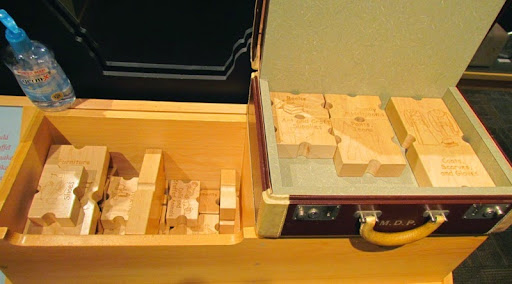
This meant leaving homes, businesses, furniture, cars, careers, schools and friends - none of which would fit into a single suitcase. What they could sell, they sold for pennies on the dollar, most they just had to give away. They were first placed in assembly centers constructed at racetracks, fairgrounds, any place big enough to hold so many people. This stayed here for 6 months until August when 10 ‘camps’ had been constructed in remote locations, far away from the coast. One of these was in Cody, WY, the Heart Mountain Relocation Center, named after the mountain that loomed over them in the background.
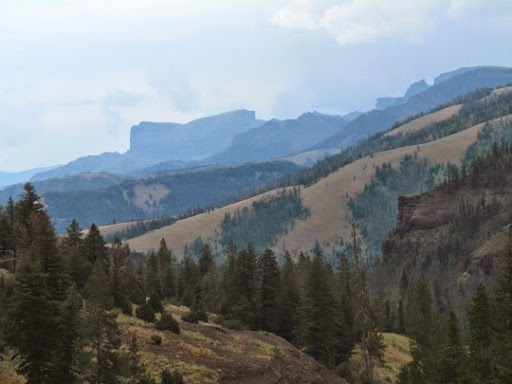
In the end, 14,025 people lived here, enough to make this the 3rd largest city in Wyoming. All behind barbed wire, searchlights and guards w/ guns. Here's a new guard tower on the grounds built to look like the guard towers at Heart Mt.
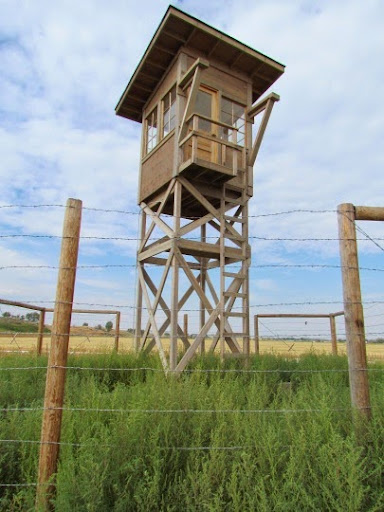
The speed with which the barracks were built guaranteed that they were poorly constructed, drafty, cramped, uninsulated and thoroughly uninviting to live in. Oh, yeah, they were built using ‘green’ wood which shrank as it dried, leaving gaps between each board. The original plans called for insulation but only tar paper was put on the outside as protection from the wind. But, this is Wyoming and it gets cold - on January 17, 1943, the high temperature was 13 degrees - BELOW zero. Remember that these people are from California and not used to temperatures like this.
Each barracks building was 120’ x 20’ and divided into 6 ‘rooms’ one for each of the 6 families who were assigned to this barracks. These rooms were 20’ x 16’ or, for larger families, 20’ x 24’. There were no dividing walls in the barracks. Each ‘room’ had a coal burning stove for heat and a single light fixture hanging from the ceiling. Coal was dumped in a central location daily and each family took what they needed. Each internee was issued an army cot and 2 blankets.
Several families lived in the same barracks with no dividing walls and families hung blankets between them for privacy. They tried to make their new ‘homes’ as cozy as possible: they built furniture, they hung art that they made in the camps and they bought things in nearby towns with what money they had. Strangely, most of them accepted their condition - if this is what their country needed to fight the war, so be it. They didn’t like it and thought it unfair but stoically accepted it. ‘Shikata ga nai’ - it can’t be helped.
Below is an example of a ‘home’ (probably 20’ x 20’) in the museum.
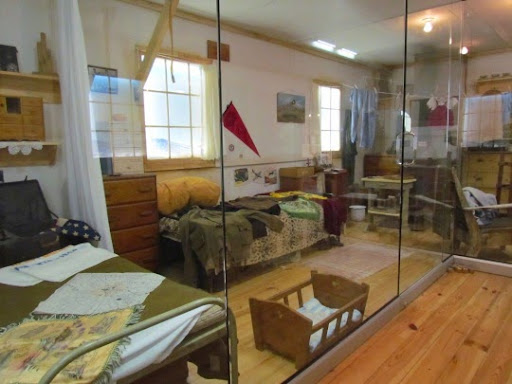
‘I was in block 14, and when we moved in we ... got off the train and were put on backs of trucks. And the wind was blowing and the dust was blowing and we were assigned our appartment. The tarpaper wasn’t on it yet ... and you could see the cracks between the boards and the dust sifting in. You were given an army cot and a mattress ... the pot bellied stove was your heat. And one single light bulb dangling from the ceiling.’
Kara Kondo
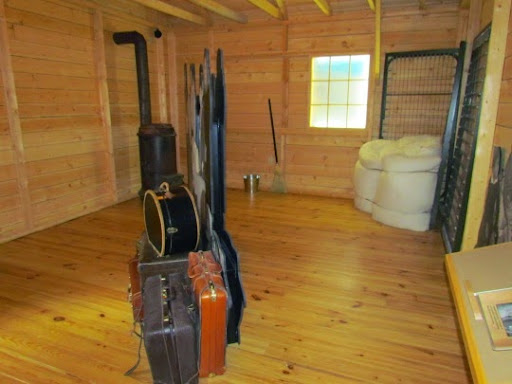
Here’s a diagram of how one block in the camp was laid out.
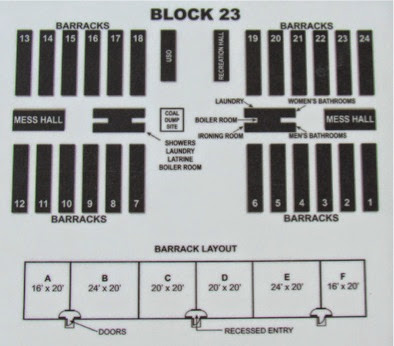
We walked up to a small hill and looked out given the markers they told us: from the brick house off in the distance to the hill off that way to the buildings here - it was huge. Barracks to house 14,025 people along with schools, cafeterias, kitchens, playgrounds, sheds, etc take a lot of space. Eventually, Heart Mt. internment camp had a hospital, police department, fire department, post office, sewage treatment plant, barber shop, beauty shop, dry cleaners, two movie theaters, library, newspaper and other things that any town needs.
But what to do? No jobs, no careers, no place to go, nothing to do. No hope. Now what? Not much to do in the camps. For the kids, the parents tried to make it as normal as possible: sports, Scouts, swimming pool, after school activities etc.
They built schools for their children and had sports teams and clubs. It must have been difficult for the history teachers to teach about ‘democracy’ and ‘civil rights’ and ‘freedoms’ when teaching to young people who are incarcerated in a prison camp because of how they look. The class of 1943 had 249 graduates, the class of 1944 had 304 and the class of 1945 had 250. Ted Fujioka, the first high school student body president, enlisted in the US Army and was killed in France. Interestingly, they drafted young men out of camp to fight in WWII. Imagine that! You and your family are imprisoned in a camp by your government and this same government tells you that you have to fight for it. On the other hand, no matter how incongruous, many Japanese both volunteered and were drafted, were sent to Europe to fight and were one of the most decorated units in the war.
‘No combat unit in the army could exceed (them) in loyalty, hard work, coursge and sacrifice. Hardly a man of them hasn’t been decorated at least twice and their casualty lists were appalling. We were proud to be wearing the same uniform.’
Bill Mauldin, a soldier and cartoonist for the military paper
Communal meals, communal showers, communal baths, several families living in the same barracks: it was difficult to find any private moments. To simulate the lack of privacy, in the bathroom stalls in the women’s bathroom today, there are mirrors on each side of the stall. Very eerie, makes you feel as if there is someone next to you, just like the bathrooms in the original camp. Each group of about 10 barracks had a bathroom/shower building. Privacy? Nonexistent. No stalls in the womens bathrooms nor in the mens. Each 10 barracks also had its own cafeteria - no eating as family units.
The Heart Mountain WWII Japanese American Confinement Site tells the stories of those confined here and how they endured their confinement. It is a privately funded museum and many of the board members were youngsters when they were confined here.
We talked with the young woman at the front desk and asked why she was working here. Her family lived in one of the houses in Cody that was built with the wood from the barracks when the confinement center closed and the barracks were no longer needed. She’s studying anthropology in college and this fit right in. We really enjoyed this museum and the stories that were told.
Back at the RV, we ate dinner, enjoyed the view and relaxed and checked the weather for our drive tomorrow.

No comments:
Post a Comment